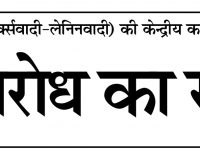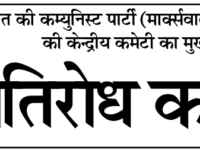 On May 10th 1857, soldiers of the British Indian Army rebelled in Meerut and captured the Cantonment there. A day later the victorious soldiers triumphantly marched into Delhi. Their war was to liberate the country from the rule of British colonialists ruling under the aegis of East India Company. They proclaimed Bahadur Shah Zafar as the leader of their uprising who, though advanced in age, agreed to their urgings. This first pan-India war of independence against colonial rule shook the foundations of British colonial rule in India which was saved by the oppressive traitorous feudal kings and served by usurious mahajans. It was the last act of the independent feudal kings and the advent of Indian peasantry on the national scene. They displayed great bravery, made unprecedented sacrifices, forged unparalleled unity to throw out colonial rule particularly the unity of the people cutting across social divisions, especially between two largest religious communities, Hindus and Muslims, in the then India which united in their common aspirations despite difference in religious persuasions.
On May 10th 1857, soldiers of the British Indian Army rebelled in Meerut and captured the Cantonment there. A day later the victorious soldiers triumphantly marched into Delhi. Their war was to liberate the country from the rule of British colonialists ruling under the aegis of East India Company. They proclaimed Bahadur Shah Zafar as the leader of their uprising who, though advanced in age, agreed to their urgings. This first pan-India war of independence against colonial rule shook the foundations of British colonial rule in India which was saved by the oppressive traitorous feudal kings and served by usurious mahajans. It was the last act of the independent feudal kings and the advent of Indian peasantry on the national scene. They displayed great bravery, made unprecedented sacrifices, forged unparalleled unity to throw out colonial rule particularly the unity of the people cutting across social divisions, especially between two largest religious communities, Hindus and Muslims, in the then India which united in their common aspirations despite difference in religious persuasions.
1857 and its aftermath has shaped Indian history and society since then and remains relevant to this day. Significance of two aspects stands out in particular. India continues to be happy hunting ground for the imperialist capital of the former colonial powers of the west who dominate the different aspects of the economic life of the country. The Indian rulers, continuing the inglorious tradition of the despised feudal kings who saved the colonial rule in 1857, are serving the interests of imperialist capital, parroting the imperative need for this capital for India’s ‘development’ and designing to increase further the stranglehold of imperialist capital on the country. The policies are being framed not in the interest of the Indian people, but in the interest of foreign and domestic corporate. Indian rulers are gifting the natural resources of the country to the foreign MNCs and Indian compradors at throw away prices. The great feast of loot and plunder is on which is being hailed as a great saga of development by their apologists and beneficiaries even as the lot of the common people continues to worsen. The only economics they know and practice is the economics of neocolonial dependence and exploitation. British colonialists and later different imperialists in league with the rulers subservient to them, are continuing to exploit our rich natural resources, labour power and to control Indian market.
1857 stands out for its attempt to shape the future of the country free of colonial rule and was a revolt against the ruin it brought upon the Indian peasantry and handicraftsmen. The Indian sepoy was a uniformed peasant. The religious distress the Indians complained of was an expression of their real distress at the colonial loot and plunder.
1857 also symbolized the unity of the people of the country against colonial rule cutting across social and religious divisions. This unity was noted even by British statesmen, including the then leader of the opposition, Disraeli. British worked systematically to undermine this unity, propped up intellectuals on all sides to propagate only diversity and no unity, only differences and no similarities, only discord and no harmony, all to suit the interests of a foreign colonial power to make India a jewel in its crown. A whole intellectual breed was brought up not only to serve as the cogs in the wheel of colonial state machinery but also to sing paeans to the colonial rulers. At that time the biggest obstacle perceived by the British was unity of Hindus and Muslims so they paid main attention to turn these two communities into enemies of each other. They patronized intellectuals to propagate that British rule was to the advantage of each one of the communities against the other, who exerted much to confuse the colonial rule with rulers coming from outside which had been so in all parts of the world; who strained much to obfuscate the basic question of loot and plunder of the country to take the booty to foreign land. Recall the concluding part of Bankim Chandra Chatterjee’s “Anand Math” where British rule is proclaimed to be beneficial for Hindus enabling them to get rid of Muslim rule and paving the way for advent of Hindu rule. And he was not alone.
Deepening the divisions among Indian people has been the instrument of state policy of first the colonial rulers and then the rulers to whom the British transferred power in 1947. They have carefully and methodically harnessed these divisions, preserved and defended the oppressive social hierarchy, all to subvert the Indian people’s struggle against robbing of the country and its people by imperialist capital and their compradors utilizing the landlords in the vast rural landscape as their social base. This has been the cornerstone of the policy of Indian rulers in addition to carrot and stick i.e. reforms and repression, sowing illusions by the former and creating helplessness by the latter which could not have enabled them to suppress so many people over so long a period of time. Even today ruling classes force down so many and such blatantly anti-people policies confident in their belief that they would be able to sidetrack these issues by playing on the social and communal divisions, by making people fight over a small piece of a pie thrown by the rulers while they could acquire the whole if they fought for it.
Even while deepening divisions and using them for maintaining their class rule and implementing anti-people and anti-national policies, the ruling classes have propagated and continue to propagate their so-called commitment to secularism. They sing of the virtues of ‘mutual tolerance’ propagating that we should tolerate each other. Now underlying this is an understanding of basic hostility of interests, lack of commonness so they should ‘tolerate’ each other. You tolerate something disagreeable. There is an extrinsic or intrinsic element of compulsion in this underlining the inherent mutual incompatibility. The secularism propagated by the ruling classes, whatever their sincerity in practice, is shaped by the policy of British colonial rulers to keep the communities apart and in mutual hostility so that the rulers can pretend to stand above them and utilize it in their own interests.
This secularism stands opposed to the secularism of common aspirations, shared history, culture and destiny, shared vision of society which is forged in the crucible of common struggle in defense and furtherance of common interests. This secularism is distinct from and opposed to secularism of the fighters of 1857 who fought to reclaim the country from the foreign rulers, who rallied together to fight for common interest, for common goal of freeing the country. The secularism of the fighters of 1857 was positive secularism. The rebelling soldiers, a good majority of them Hindus, insisted and prevailed upon Zafar to lead their uprising.
Bahadur Shah Zafar became the rallying point of this war of Indian people. Bahadur Shah Zafar became the symbol of this people’s uprising at pan-India scale against colonial rule and their attempt to take their destiny into their own hands. He died in colonial captivity in the then Burma (now Myanmar) longing for two yards of land for burial in his homeland. These two yards of land were already arranged in Mehrauli for the purpose. But the British rulers wanted to remove this symbol of the independence of India from public mind as well as public vision. Zafar died in captivity on November 7, 1862.
Not only British colonial rulers, but even the Indian rulers in power since 1947 did not take up the issue of providing two yards of land to Zafar. Probably this was not expected from the rulers who pride themselves for having benefited from the 200 years of colonial rule over the country or who had proclaimed themselves to be citizens of the empire. They limited themselves to paying formal tributes but probably could not tolerate this symbol of common aspirations of Indian people and their war to free the country from colonial yoke. They could not be expected to bring here to India a symbol which they fear in death as much British colonialists feared when he was alive, as he represents all that they are opposed to. They represent subservience to imperialists and division of the people on communal lines.
Leader of that people’s uprising what is popularly called First War of Indian Independence, longed for two yards of land for his burial in his beloved land. The British obviously denied him, and the rulers who came after transfer of power in 1947 continue to do so till now. They formally pay obeisance to 1957 war, but really have done everything to erase its memories. It is for Indian people to raise their voice for providing the two yards of land longed for by Zafar. This voice should be raised loudly enough to reach the rulers. This voice should be raised powerfully enough to force the rulers to listen. Let May 11, the day this war reached Delhi in 1857, be the beginning of this campaign.



